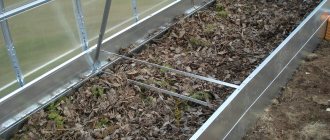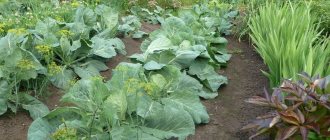To get a good harvest, you need to properly prepare the beds for cucumbers in the open ground with your own hands. After all, all vegetable growers know that pumpkin crops produce maximum yield only on cultivated, well-structured and highly fertile soils. The green vegetable beloved by all summer residents is no exception - the cucumber, the fruits of which are actively absorbed in the summer diet and are used for preparations for the winter (preparing vegetable salads, pickled and salted gherkins, and even freezing greens).
How to prepare beds for cucumbers in open ground
Despite the fact that cucumbers are considered one of the most unpretentious crops, they do have some “whims”. For example, they need the right predecessors.
It is best to place the beds where tomatoes, cabbage, and peas were planted. And after squash and zucchini, you shouldn’t plant cucumbers.
Also, the place in the garden should be protected from wind and drafts.
If the site is located in an open area and there is no secluded corner for a garden bed, you can plant curtain plants around the perimeter. Corn or sunflower will do.
What plants will be the best neighbors for cucumber beds:
- melons, watermelons;
- cabbage;
- the salad will stimulate the root system of the cucumber;
- onions, parsley, garlic, spinach - these greens heal the air and soil;
- dill - attracts beneficial insects - ladybugs that fight pests;
- calendula;
- radish repels spider mites;
- beans provide nitrogen replenishment;
- corn.
With a suitable neighborhood, the harvest will be rich, and there will be enough cucumbers not only for summer salads, but also for twists.
It is worth carefully selecting “neighbors” for cucumbers.
When is the best time to do it?
You can build a warm cucumber bed in both autumn and spring. The only difference is the composition of biological fuel. The autumn ridge is filled with fresh grass and other plant debris.
It is advisable to equip it in October-November, before frost sets in. Any organic substances are used for spring ridges. It must be built immediately after the snow melts.
How to prepare the soil
To make a cucumber bed with your own hands according to all the rules, you need to know about the preferences of the crop.
This plant loves organic fertilizers and soils with high air and moisture permeability. It can be light or medium loam. The optimal acidity level is 6.2 – 6.8 pH.
List of necessary fertilizers:
- food waste;
- shoots;
- mown grass;
- humus (1 kg per 1 sq. m);
- nitroammophoska (per 1 sq. m. 1 tbsp. spoon).
With such fertilizing, the soil will be warmer and its nutritional properties will increase.
Features of growing cucumbers in boxes
I place arcs over the bed and cover them with film. A week later, I place stakes 1.7 m high along the edges of the bed, attach a crossbar to them and tie up the plants. Until the end of May, I cover the cucumbers with spunbond.
Over the entire season (and cucumbers grow in this bed until the end of August), I feed them 3 times and only with green fertilizer, adding a handful of wood ash to a bucket of solution. Twice - in mid-June and in the first ten days of July - I spray the mulch and lower leaves with a solution of Fitosporin. I water cucumbers rarely and only at the root.
Types of beds for cucumbers, optimal sizes
Most summer residents, first of all, make sure that the beds are nutritious and warm. But cucumber beds come in different types, and before you start arranging them, you need to choose which one is best suited for the site.
First, let's talk about the technology for preparing ordinary beds. The standard size for them is 1m. If the soil is heavy, it needs to be mixed with humus and sand (1 bucket of each “ingredient” per 1 sq. m) and dug thoroughly. Then loosen and level.
In different climatic conditions, the arrangement of beds for planting cucumbers is somewhat different. If you are making a regular garden bed, then you should take care of the supports on which the plant will be attached.
Important: if you pour soil 2 cm above the ground around it, it will warm up better during the day and cool down more slowly at night. And in case of night frosts, it will be enough to cover the bed with a film thrown over the arc. This will protect the future harvest from sudden temperature fluctuations.
Warm beds
Is there any objective benefit from arranging a warm garden bed? Undoubtedly. If everything is done correctly, the harvest can be harvested as much as 20 days earlier. And if you make every effort, you can grow cucumbers in the ground faster than in a greenhouse.
Warm beds can be deep or high.
The main advantage of sunken beds is that the moisture in them takes longer to dry out. This means that it will be possible to reduce the frequency of watering. In height it will be at the same level as the general ground or slightly higher than it.
How to do:
- Dig a trench (depth 1 m, width 1.5 m).
- Set the excavated layer aside.
- Place a small amount of expanded clay into the base and level it along the bottom to ensure soil drainage.
- Lay roots, massive branches, stems and other wood waste in a layer of 40-45 cm, which will rot for a long time (especially important for clay soils and areas near which there is groundwater).
- Lay humus, compost, organic food waste, fallen leaves or tops in a 45-55 cm layer.
- Tamp the layer thoroughly by pouring water at room temperature over it.
- Cover with polyethylene.
- Leave for 1 week.
When time passes, the bed needs to be compacted again and the depressions filled with a mixture of soil and compost (1:1). Cover again with film and leave for another week. After this, the soil will be ready for planting cucumbers.
Warm beds can be deep or high.
Vertical beds
If there is very little space on the site, vertical trellises will help out, which will serve as additional support for growing cucumbers. If you choose this type of garden bed, you won’t have to compromise on the harvest of crisp green vegetables. In addition, making them with your own hands is very simple.
Procedure:
- Place manure with a diameter of 0.5 m.
- Add soil.
- Install 1.5-2 m supports in the center of the circle.
- Sow cucumbers around the supports.
- Protect the seedlings from the cold.
- When the seedlings begin to sprout, thin them out until there is an interval of 25 cm between seedlings.
- Carefully tie the seedlings to the supports.
After this, all that remains is to periodically water and fertilize the plants. Once the crop has sprung, it will be extremely easy to harvest, without the risk of damaging the stems or leaves.
Another advantage: most diseases do not “stick” to cucumbers in vertical beds.
A vertical bed will not take up much space on your site. But the harvest will be good, since most diseases do not stick to cucumbers in such beds.
Another way to make an unusual bed is to use chain link. This is a favorite material of gardeners, from which barriers and shelters are made. And with a minimum of effort, you can create a space for growing cucumbers.
You will need:
- net;
- dry grass/straw;
- priming;
- compost;
- drainage;
- sand;
- film.
Bend the mesh into a pipe (approximate diameter - 0.9 m), fix the ends. Place polyethylene under the cylinder. Line the walls with grass/straw, fill with a mixture of soil, drainage, sand and compost. Plant seedlings at intervals of 15 cm.
A layer of grass or straw will protect from the cold, and in case of frost, the bed can be covered with plastic wrap.
If it is not possible to regularly water the plants, it is better to line the walls of the cylinder with film instead of dry grass.
Raised beds with box
Any sufficiently capacious container will be suitable as a “base” for such a bed. For example, it could be a sawn barrel or a wooden box.
How to prepare a place for growing cucumbers:
- Pour decomposed household and kitchen waste, plant debris, and weeds into the bottom (the largest ones go down, the small ones go up).
- Compact the layer.
- Pour a 15-20 cm layer of garden soil mixed with humus (1:1) and ash.
- Install support and trellises.
- Sow the hatched seeds.
- Cover with non-woven material.
- Insulate.
Important: it is better to prepare such a bed in the fall, when there are a lot of remains of tops, leaves and other organic matter on the site.
It is prohibited to take the remains of diseased trees and shrubs.
When the sprouts sprout, remove the insulation and care for it as usual. In such beds, oburs grow quickly and look beautiful on the site.
Caring for cucumbers in such a bed is ordinary, but the whole structure looks interesting and you can approach it from any direction.
Raised beds can be created in an old chest of drawers. This is an unusual and interesting solution that will not only save space on the site or provide additional space for growing vegetables, but will also look original.
Perhaps the most interesting thing is that you can grow vegetables this way even on an unglazed balcony. During the season, there will always be fresh (and even the freshest) cucumbers at home.
Hanging beds
In a small area, you can make beds that take up a minimum of space, but allow you to grow an impressive harvest of cucumbers. Suspended structures can even be placed on asphalt, suspended from walls or in any other “non-garden” location.
What you will need:
- volumetric containers that can hold at least 5 liters of fertile soil;
- drainage;
- compost;
- earth mixed with sand;
- soil with humus.
Cucumbers can be grown in this way by seedlings, as well as by sowing germinated seeds directly into the soil.
The bed is organized in the usual way: you need to lay compost on the bottom, cover it with a mixture of soil, sand and drainage, sprinkle it with soil on top (a layer of about 10 cm).
You need to place a stick next to each bush to check the need for watering.
For a suspended structure, you can make an automatic watering tool from a plastic bottle. To do this, you need to make holes in it on the sides (at the level of the root system). The cucumbers themselves will absorb the required amount of moisture, and after a few days the liquid just needs to be added to the neck.
A 2-liter bottle can provide one plant with moisture for three days.
If you use a flower pot as a hanging bed, then do not forget that the plants require good drainage and regular watering.
What are the advantages of hanging beds:
- compact;
- they can be placed anywhere;
- when it gets colder, the beds can be removed to a warm place;
- warm up quickly in spring.
But hanging beds need to be carefully monitored. The soil can quickly overheat and dry out. Plants will require regular watering. You will also need to ensure drainage of excess fluid.
You can use ordinary flower pots as hanging beds (but do not overload them with a large number of seedlings), as well as sewn organizers with spacious pockets. It is better to place them on the south wall of the building. It is necessary to take care of strong hinges on which the beds will be attached.
Reviews from gardeners
Irina, Tula
First, fallen birch branches, leaves, after spring cleaning of the site, then from the compost heap, unrotted plant residues, then from the compost heap, already half-rotted and from the very bottom of the heap, already rotted compost, a small layer of humus and the last layer of soil on which the compost heap lay , the height of the bed turned out to be about 45 cm.
Source: forum.prihoz.ru
Inna, St. Petersburg
You just need to make sure that such a bed is not in a place where the groundwater is high, or water simply accumulates (some kind of lowland) - the “filling” does not decompose, and the roots simply rot.
Source: dacha.wcb.ru
How to make a warm bed for cucumbers in early spring with your own hands
Many summer residents are interested in how to make a warm bed of manure for cucumbers in the spring. This is not at all difficult, but there is one caveat: you will need horse manure, which, when decomposed, maintains heat for more than 3 weeks, which is important in the spring season. Plus, it enriches the soil with useful substances that will affect the harvest.
You need to make a garden bed as soon as the snow melts.
Action plan:
- Fill the manure to 18-22 cm (you can also cover the walls of the trench with it).
- Fill the hole with soil, you can mix it with humus in a 1:1 ratio.
- Sprinkle with warm water.
- Season with ash.
- Hide under film for 7 days.
After this, the bed will be ready for planting cucumbers. This method allows you to harvest vegetables much earlier.
However, it is worth considering the possibility of repeated frosts and considering ways to cover the seedlings. A frame made of chain-link, metal or wooden frame and film will help out in case of cold weather and will create greenhouse conditions. As soon as the bad weather recedes, the insulation can be removed.
Due to the fact that cucumbers are unpretentious plants, they can be grown anywhere. They have a small root system, which is enough even with a minimal amount of soil.
Secrets and tricks
If you notice that the earth quickly dries out and heats up, then use hydrogel. Just add about one-fourth teaspoon of hydrogel per liter of soil. Thus, if there is an excess of moisture, the hydrogel will collect it, and if there is a shortage, it will release it.
If you planted cucumbers in a hanging container, then it makes sense to place it under a canopy or canopy. This will save you from overflowing during heavy rain.
If you are not an ardent gardener and are rarely at the dacha, then you should make a vertical bed with a trellis and equip a drip irrigation system.
The article discusses in detail how to make a bed for cucumbers in open ground. If you get creative, you can grow them anywhere. The main thing is to arrange good conditions and provide quality care.
LiveInternetLiveInternet
—Tags
—Categories
- MEAT DISHES (56)
- USEFUL TO READ (35)
- PRAYERS (16)
- COOK DISHES (14)
- WINES, TINCTURES, LIQUEURS (14)
- ALTERATIONS (2)
- CRAFTS (0)
- VEGETABLE DISHES (57)
- FISH DISHES (52)
- BODYFLEX (4)
- VINTAGE WORKS (5)
- BAKERY (216)
- KNITTING (7)
- COOKING WITH CHICKEN (58)
- COOKING FROM BY-PRODUCTS (18)
- GARDEN DECOR (22)
- DECOUPAGE (114)
- DECOUPAGE BOTTLES (24)
- DECOUPAGE ON PLATES (12)
- DO IT YOURSELF (71)
- FOR CHILDREN (63)
- PREPARATIONS FOR WINTER (70)
- WINTER PREPARATIONS FROM VEGETABLES (56)
- SNACKS (37)
- CASSERLES (28)
- HEALTHY FOOD (15)
- Health (379)
- IDEAS FOR YOUR HOME (14)
- MUSHROOMS (11)
- CARDBOARD (2)
- INTERESTING ABOUT DECOUPAGE (13)
- CINEMA (15)
- CLIPART (10)
- COMPOTES, JAM (39)
- CUTLETS (26)
- MUSIC (18)
- CARTOONS (9)
- FOR SWEET (103)
- NEW YEAR'S DECOUPAGE (23)
- NEEDED FOR COMPUTER (71)
- PANEL (5)
- USEFUL FOR MAKING MOVIES (39)
- PARABLE (5)
- ABOUT THE LIRA DIARY (8)
- ENTERTAINMENT (3)
- MISCELLANEOUS for ProShow Producer (6)
- Garden, vegetable garden (249)
- SALADS FOR THE HOLIDAY (39)
- SCRAP SETS, CLIPART (61)
- SALT DOUGH (6)
- SAUCES (24)
- POEMS (10)
- SOUPS (13)
- PHOTOSHOP (28)
- COLD PORCELAIN (7)
- SEWING (13)
- This will come in handy in life (158)
—Quote book
Meringue in the microwave is a wonderful dessert for coffee or tea in record time. Prigo.
How to connect a USB flash drive to a smartphone. Sometimes the safest way to store data is on a USB drive: it.
Tangerine peels are an interesting use for tangerines, especially during the New Year holidays.
What materials are raised beds made from?
As a basis for creating high beds, summer residents have adapted to using seemingly completely unusual materials, in comparison with the accepted standard ones.
- Brick, stone. Beds made from them are reliable, look beautiful, and are long-lasting. However, the cost of the material, plus the cost and time for the construction itself, is quite inconvenient.
- Vine. A fairly affordable material, it allows you to create a design of any shape. This design is short-lived, it is enough for one season, and next year you will have to make it all over again.
- Metal. The boxes can be made portable and the location of the beds can be changed annually, if necessary. The outside can be painted. The costs for such a box are high, and welding work will also be required. In addition, the material will need to be treated with anti-corrosion agents.
- Slate. The material is inexpensive, the box is easy to assemble, and looks aesthetically pleasing. Slate requires care because it is quite fragile.
- Plastic bottles. Bottles filled with sand or other material are dug upside down into the soil. They are tied around the perimeter with wire.
Wood is most often used for raised beds. Of all the materials, this is the most practical option. Moreover, it is environmentally friendly. Wooden boxes have their advantages:
- The service system is quite simple;
- Even an inexperienced summer resident is able to install a wooden box on his own;
- Wood is an easy-to-work material and does not require expensive tools for installation;
- In extreme heat, plants located near the sides do not get burned;
- There is always material available to create a structure.











